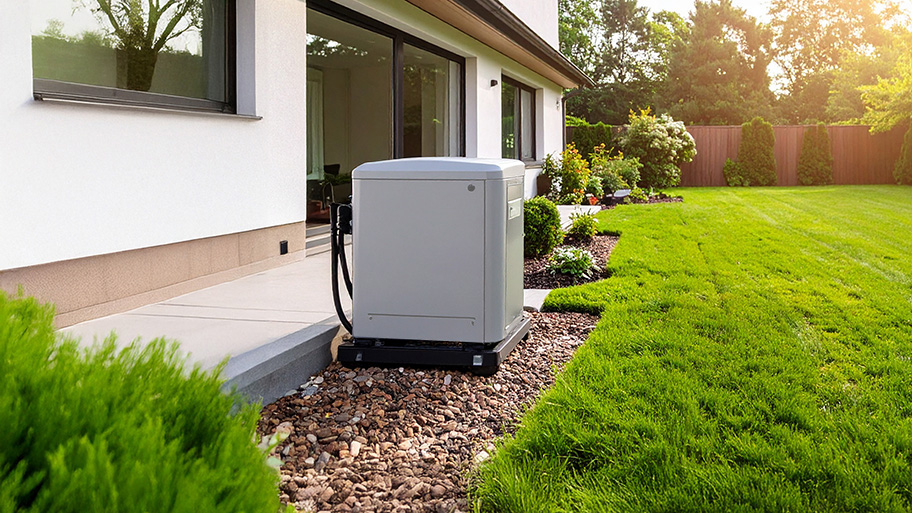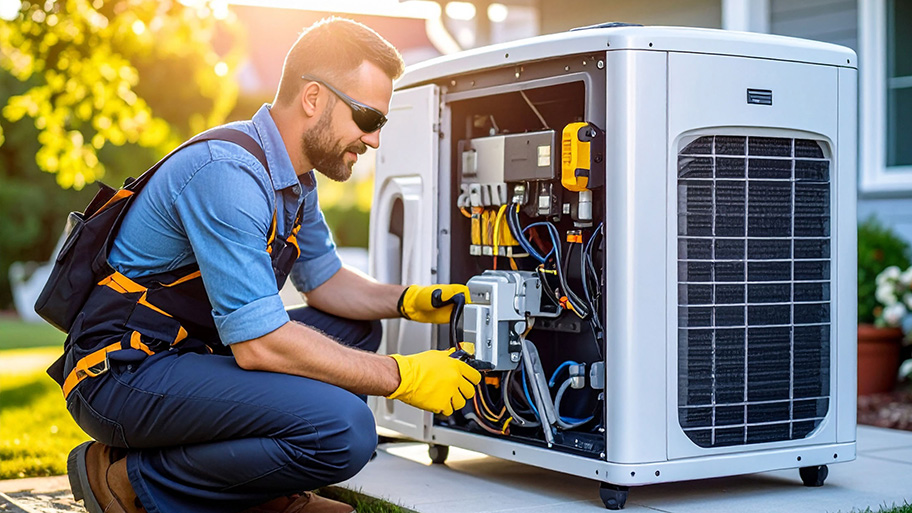
The average cost of a whole-house generator falls between $5,000 and $25,000. Keep reading to learn how much you can expect to spend.
Keep everything up and running the next time there’s a power outage


Whole-house generators come in an array of wattage capacities to meet different needs. A local electrician or whole-house generator installer can help you determine whole-house generator sizing based on your electrical needs.
A sudden power outage can be a major inconvenience at best. At worst, it can leave your home vulnerable to extreme heat or cold, flood your basement, or even cause life-threatening malfunctions of medical equipment. Preparing with a backup generator ensures that even during severe weather, wildfires, or power-grid failures, life can continue safely and comfortably. Start your search with our guide on whole-house generator sizing.
Start your generator-shopping process by calculating the right size system for your home’s needs.
List the essential home devices and appliances that would need power during an outage. Keep in mind both running wattage and starting wattage, as many appliances require a temporary power surge to start up.
Total the running watts of all items. When in doubt, overestimate to avoid ending up with an underpowered generator.
To factor in starting wattage, add the highest starting wattage requirement from your list to the total.
For a safety buffer and potential future needs, multiply the final sum by at least 1.25. This calculation gives you the minimum generator capacity to consider.

There is no standard size for a whole-house generator, but a capacity of between 15,000 to 20,000 watts is a recommended size for most home generator uses, including powering lights, essential devices, and appliances. This size of generator can handle the majority of household appliances, although it’s still important to manage and balance which devices you run at the same time to avoid overloading the system. For instance, while the generator can power essential items like your refrigerator, lights, and some electronics, you may need to be mindful when adding high-wattage devices and appliances such as air conditioners or electric dryers.
| Generator Size in kW | Wattage Rating in Watts | Home Size in Square Feet |
|---|---|---|
| 7.5–9 | 7,500–9,000 | <1,000 |
| 10–15 | 10,000–15,000 | 1,000–1,500 |
| 16–22 | 16,000–22,000 | 2,000–2,500 |
| 23–36 | 23,000–36,000 | 3,000–4,000 |
| 37–48 | 37,000–48,000 | 5,000+ |
While there are general baselines to consider when it comes to square footage, wattage and appliances will play a bigger role. Let’s take a look at what the various wattages can cover.
| Whole-House Generator Sizing in kW | House Size in Square Feet | Usage Capacity Examples |
|---|---|---|
| 7.5–9 | <1,000 | Refrigerator/freezer, microwave, TV, computer, 30-gallon water heater, toaster, sump pump |
| 10–15 | 1,000–1,500 | Refrigerator/freezer, microwave, electric oven, toaster, TV, computer, hair dryer, 40-gallon water heater |
| 16–22 | 2,000–2,500 | Refrigerator/freezer, microwave,electric oven, toaster, TV, computer, hair dryer, 50-gallon water heater, central AC, washing machine |
| 22–36 kW | 3,000–4,000 | Refrigerator/freezer, microwave, electric oven, toaster, TV, computer, hair dryer, 50-gallon water heater, Central AC, washing machine, electric dryer, EV chargers, sump pump |
| 37–48+ | 5,000+ | Refrigerator/freezer, microwave, electric oven, toaster, TV, computer, hair dryer, 50-gallon water heater, Central AC, washing machine, electric dryer, EV chargers, sump pump, second refrigerator/freezer, second microwave, second TV |
For homes that are 1,000 square feet or smaller, a 7½ to 9 kW whole-house generator should power the majority of devices and devices. This is also a general size for those looking for limited short-term emergency backup. Here’s what this wattage capacity can cover:
Refrigerator/freezer: 800 watts
Microwave: 1,200 watts
TV: 350 watts
Computer: 500 watts
30-gallon water heater: 3,500 watts
Toaster: 1,100 watts
Sump pump: 1,500 watts
Total wattage: 8,950 watts
A 10-15 kilowatt whole-house generator is typically a good fit for homes that are between 1,000 and 1,500 square feet.
This size range can potentially cover:
Refrigerator/freezer: 800 watts
Microwave: 1,200 watts
Electric oven: 5,000 watts
Toaster: 1,100 watts
TV: 100 watts
Computer: 500 watts
Hair dryer: 1,200 watts
40-gallon water heater: 4,500 watts
Total wattage: 14,400 watts
A whole-house generator sizing of between 16 to 22 kilowatts is sufficient for 2,000 to 2,500-square-foot homes.
Here’s what this wattage capacity can run simultaneously:
Refrigerator/freezer: 800 watts
Microwave: 1,200 watts
Electric oven: 5,000 watts
Toaster: 1,100 watts
TV: 100 watts
Computer: 500 watts
Hair dryer: 1,200 watts
50-gallon water heater: 5,500 watts
Central AC: 4,000 watts
Washing machine: 500 watts
Total wattage: 19,900 watts
A whole-house generator that’s between 22 to 36 kilowatts is a good fit for homes that are sized at 3,000 to 3,500 square feet.
Here’s what this wattage capacity can run simultaneously:
Refrigerator/freezer: 800 watts
Microwave: 1,200 watts
Electric oven: 5,000 watts
Toaster: 1,100 watts
TV: 100 watts
Computer: 500 watts
Hair dryer: 1,200 watts
50-gallon water heater: 5,500 watts
Central AC: 4,000 watts
Washing machine: 500 watts
Electric dryer: 1,500 watts
EV chargers: 7,200 watts
Sump pump: 1,500 watts
Total wattage: 30,100 watts
A whole-house generator sized between 37 and 48 kilowatts is only necessary for larger homes of 5,000 square feet or more, or homes with a very high electrical load. Here’s what you can run simultaneously:
Refrigerator/freezer: 800 watts
Microwave: 1,200 watts
Electric oven: 5,000 watts
Toaster: 1,100 watts
TV: 100 watts
Computer: 500 watts
Hair dryer: 1,200 watts
50-gallon water heater: 5,500 watts
Central AC: 4,000 watts
Washing machine: 500 watts
Electric dryer: 1,500 watts
EV chargers: 7,200 watts
Sump pump: 1,500 watts
Additional appliances:
Second refrigerator/freezer: 800 watts
Second microwave: 1,200 watts
Second TV: 100 watts
Total wattage: 37,900 watts
Finding the right whole-house generator sizing comes down to how much power you’ll need to run your most important devices and appliances. These are the main things to consider.
In order to purchase an adequate generator that won’t fall short, it’s necessary to consider the differences between running, starting, and surge wattage. Here’s what to know.
Running wattage refers to how much power it takes to keep your appliances running. This is the figure that most appliances will use on manuals so that you know how much power is needed to keep them going.
Starting wattage is the amount of power it takes to start an appliance. This amount is much larger than the wattage needed to keep it running, sometimes two to three times more. The figure is important because your generator will need to restart any appliances that were running when the power went out, from dishwashers to AC units.
Surge wattage refers to the highest amount of wattage a generator can create. So, if all of your electronic devices and appliances were running at the time of a power outage, your generator would potentially need to accommodate the total wattage for all, plus a few thousand extra to cover a surge.
To calculate the electrical load you’ll need your whole-house generator to cover, make a list of the appliances that use electricity in your home. You can prioritize your essentials and leave off anything you can live without until the power is back on. Consult the user manuals or stickers on your appliances to determine the running wattage for each. Total everything up to get a sense of how many watts it takes to run your house each day.
This figure can be used to calculate what size generator you need using the following formula:
Running wattage (R) + Starting wattage (R x 3) = Total wattage needed
| Appliance | Wattage |
|---|---|
| Refrigerator/freezer | 600–800 |
| Microwave | 1,200 |
| Electric range | 2,500 per element |
| Electric oven | 5,000 |
| Toaster | 1,100–1,700 |
| TV | 100–350 |
| Computer | 500–2,000 |
| Hair dryer | 1,200–1,500 |
| Space heater | 1,300 |
| Water heater | 3,000–5,500 |
| Central AC | 2,000–4,000 |
| Window AC unit | 600–1,500 |
| Washing machine | 300–500 |
| Electric dryer | 1,500–5,000 |
| EV chargers | 7,200 |
| Sump pump | 1,500 |
Several factors will contribute to finding the best whole-house generator size for your home. Your local home generator installer will be able to provide the best guidance when it comes to whole-house generator sizing. These are the main things to consider.
The biggest factor in determining the appropriately-sized home generator is your home’s electrical load. Be sure to consider starting versus running wattage as you make your calculations. If you’re looking to keep your budget lower, prioritize your bare essentials and leave off unnecessary appliances or electronics.
In general, the larger the home, the more wattage will be needed to keep things running during power outages. Still, the overall size of the home will take a back seat to how many appliances and electronics you’ll need to run, so be sure to consider electrical load above all else.
Investing in energy-efficient appliances and devices can help you get a better bang for your buck when shopping for a whole-house generator. The lighter the power consumption, the lighter the load.
In regions with extreme temperatures, HVAC systems may need more power to maintain comfortable indoor temperatures, increasing the overall load on the generator. Or, in more mild climate zones, HVAC might not even be as essential to include.
Whether it’s additions to your square footage or your family, future growth may increase the electrical demands of your home. Choosing a generator with some additional capacity can help ensure your whole-house generator can adapt to the changing needs of your home.
Choosing the right size backup generator is crucial for meeting your power needs during an outage. A generator that is too small can result in power failure and potential damage to the unit if it’s overloaded. On the other hand, a generator that is too large can be wasteful and not cost-effective.
For whole-house generators that are too small for your home, you might consider adding a portable generator or inverter generator as a supplement to avoid overloading your standby generator. Keep in mind that these generators can’t get wet, so you may run into issues if your power outage is accompanied by inclement weather. You’ll also need to keep alternative fuel in stock to run these generators, which will add costs and potentially cause issues if you run out during a power outage.
However, if your current whole-house generator can’t accommodate your most important essentials, such as HVAC, lights, and medical equipment, or if you’re in an area that sees frequent outages, upgrading may be the safest way to prepare. Get in touch with a local electrician to learn more about your options and what size of standby generator will fit your home’s needs.
From average costs to expert advice, get all the answers you need to get your job done.

The average cost of a whole-house generator falls between $5,000 and $25,000. Keep reading to learn how much you can expect to spend.

The cost to install a generator transfer switch depends on several factors. Our guide will help you understand all of the costs.

Keeping on top of generator maintenance and repairs gives you extra peace of mind as a homeowner. Find out how much regular generator maintenance costs.

Generators are a home essential when a power outage strikes. Compare home standby generators vs backup battery systems to find the best one for you.

Traditional and inverter generators can provide off-grid or emergency power. Learn the pros and cons of a traditional generator vs. inverter generator.

A portable generator can serve several uses beyond its traditional purpose. If you’re looking for ways to put your generator to work, our guide can help.